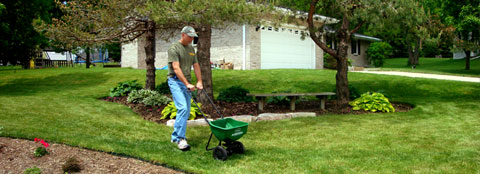Milorganite Application

Uniformity
Each granule of Milorganite contains the exact same nutrients. Segregation, caused by poor blending or handling of fertilizer mixes shows up as streaking in lawns. Because each granule of Milorganite is identical to all others, streaking is much less likely to occur. Milorganite’s uniform granules also ensure that spread patterns remain consistent. This is particularly important when you use a rotary spreader. The pattern width and uniformity are affected by two factors: the quality and condition of your spreader and the consistency of the fertilizer you spread.
Slow-release nitrogen
Milorganite releases its nitrogen through the action of soil microbes. When moisture and temperature are adequate for soil microbes to grow, nitrogen is mineralized (converted from the organic to the mineral form) and Milorganite’s nitrogen is released into the soil. When soil and growing conditions are poor, Milorganite’s nitrogen stays in the water insoluble form.
Nutrient release is slow in extreme weather and moisture (either too much or too little) conditions. Nitrogen release peaks with moderate temperatures of late spring, slows with excessive summer heat and increases again with moderating temperatures of fall. This follows the same level of activity that plants have during those times. The result is a minimum loss of nutrients and the most efficient use of fertilizer. In the tropics, nutrient release will occur whenever moisture is sufficient to support growth.
Long lasting slow-release nitrogen
Milorganite’s nitrogen is normally released, depending on weather conditions, over an 8 to 10 week period. As a general rule, applying Milorganite every eight weeks ensures that a steady supply of this nutrient is available.
Slow, even greening
Iron is necessary to make chlorophyll, and chlorophyll gives plants their green color. While plants differ in how deep this coloring is, anything that enhances the formation of chlorophyll enhances their green color. Iron also improves turfgrass color when nitrogen applications have been reduced. The iron in Milorganite is organically complexed. It stays in a form available to plant roots. Because it is organically complexed, Milorganite iron does not stain concrete walks and patios.
Non-burning Milorganite
Milorganite contains virtually no chemical salts. Chemical salts, found in high concentrations in most synthetic fertilizers, can dehydrate and burn plants. This is especially true in low moisture conditions. Droughty soils add to this burn potential.

